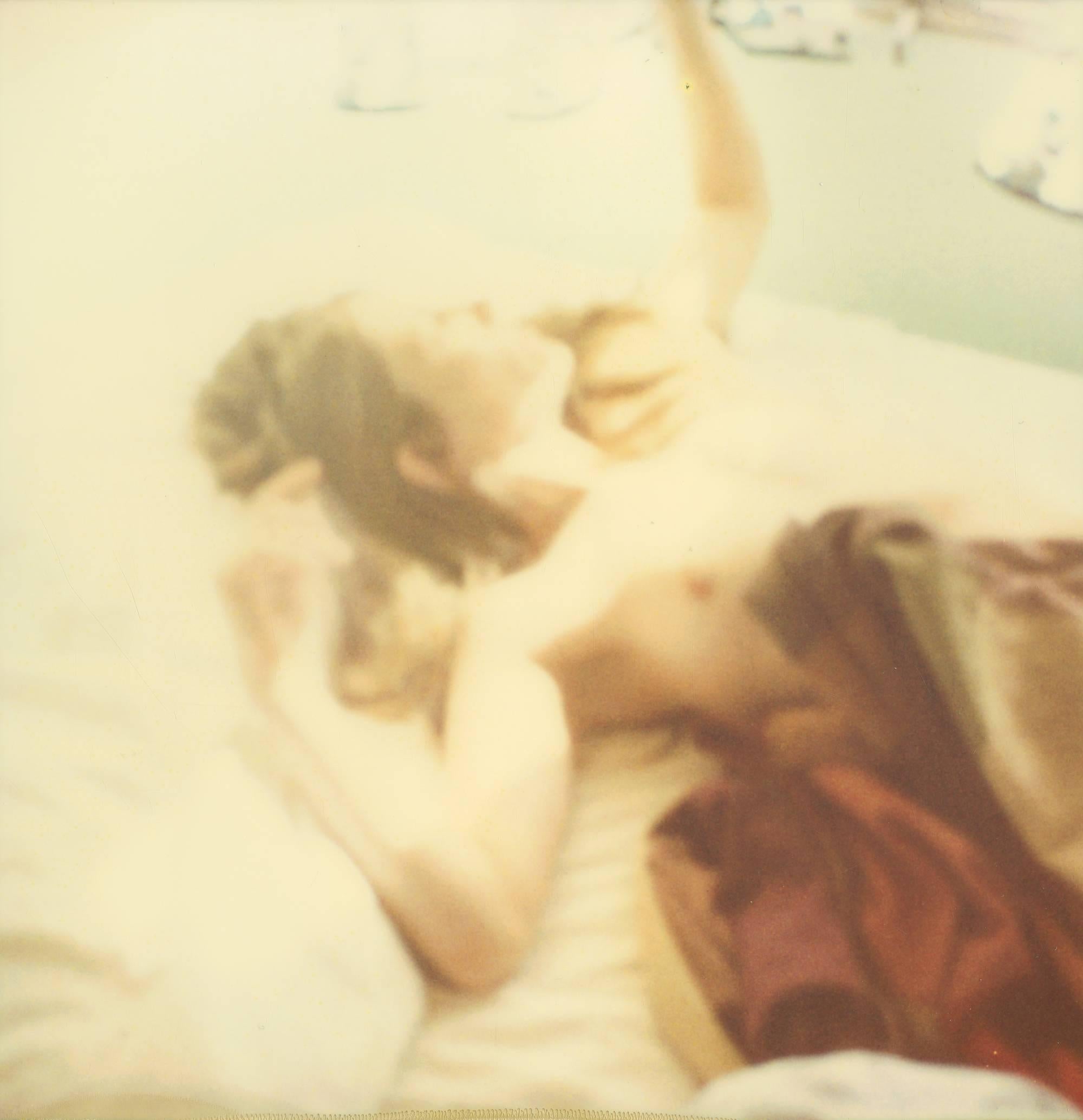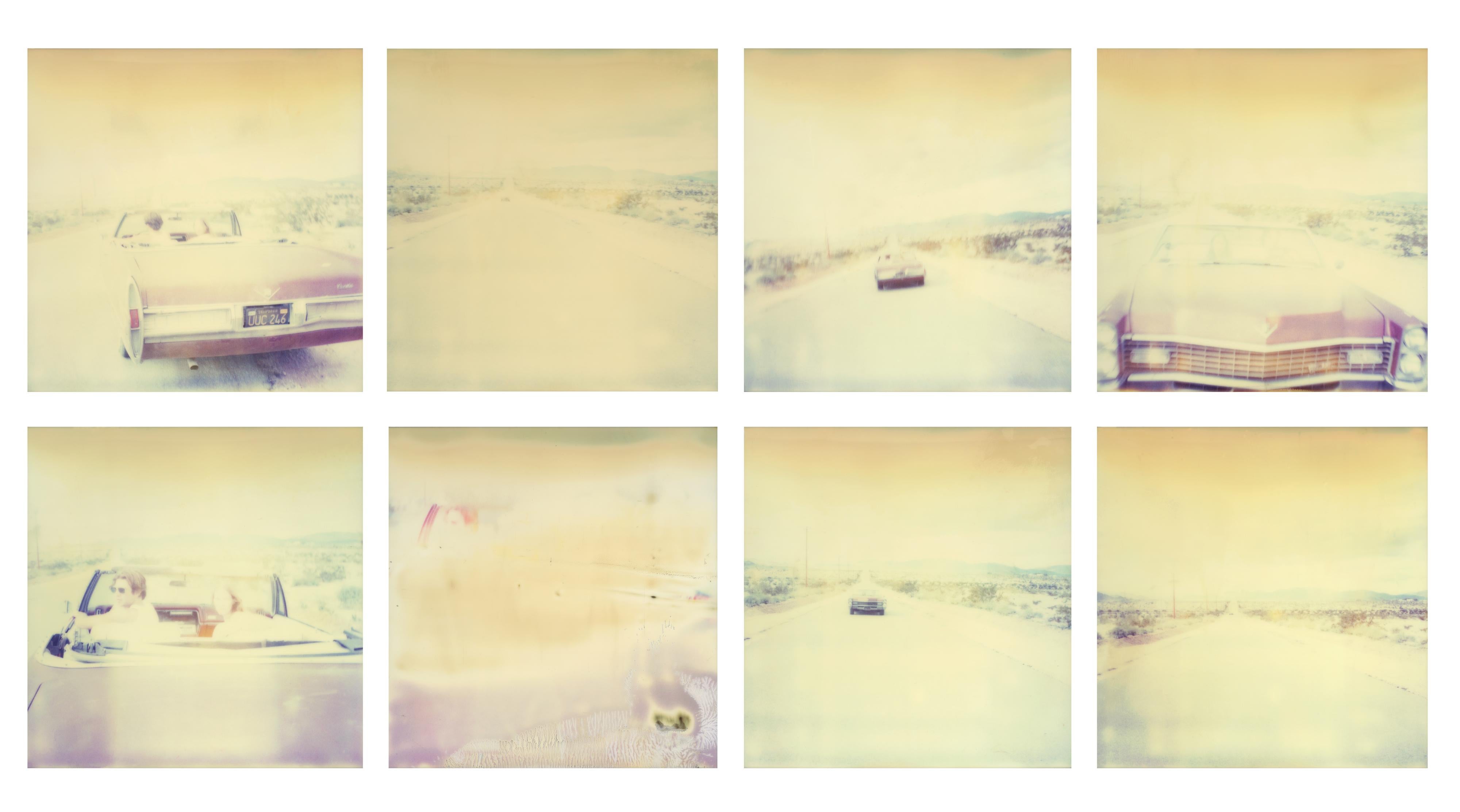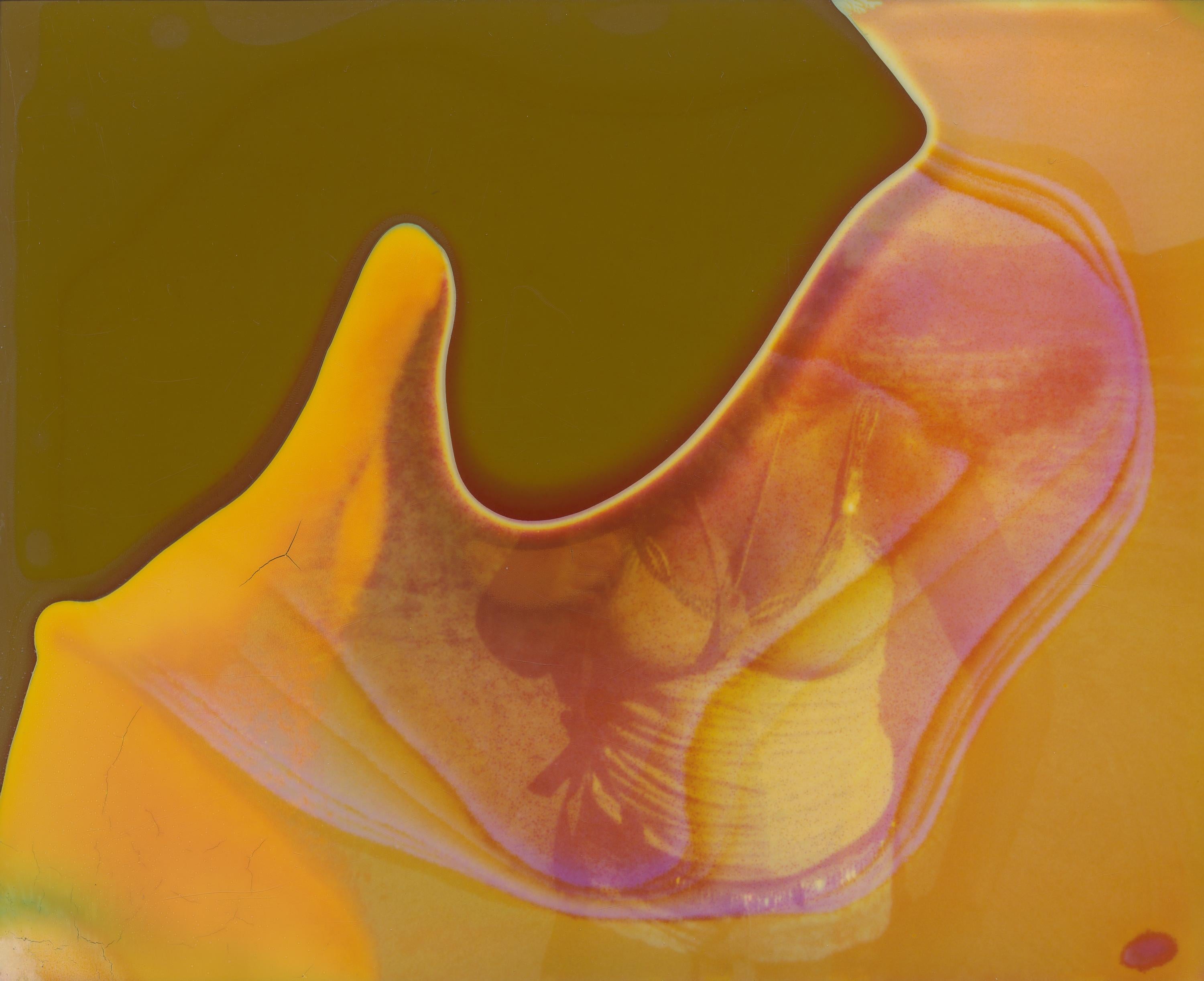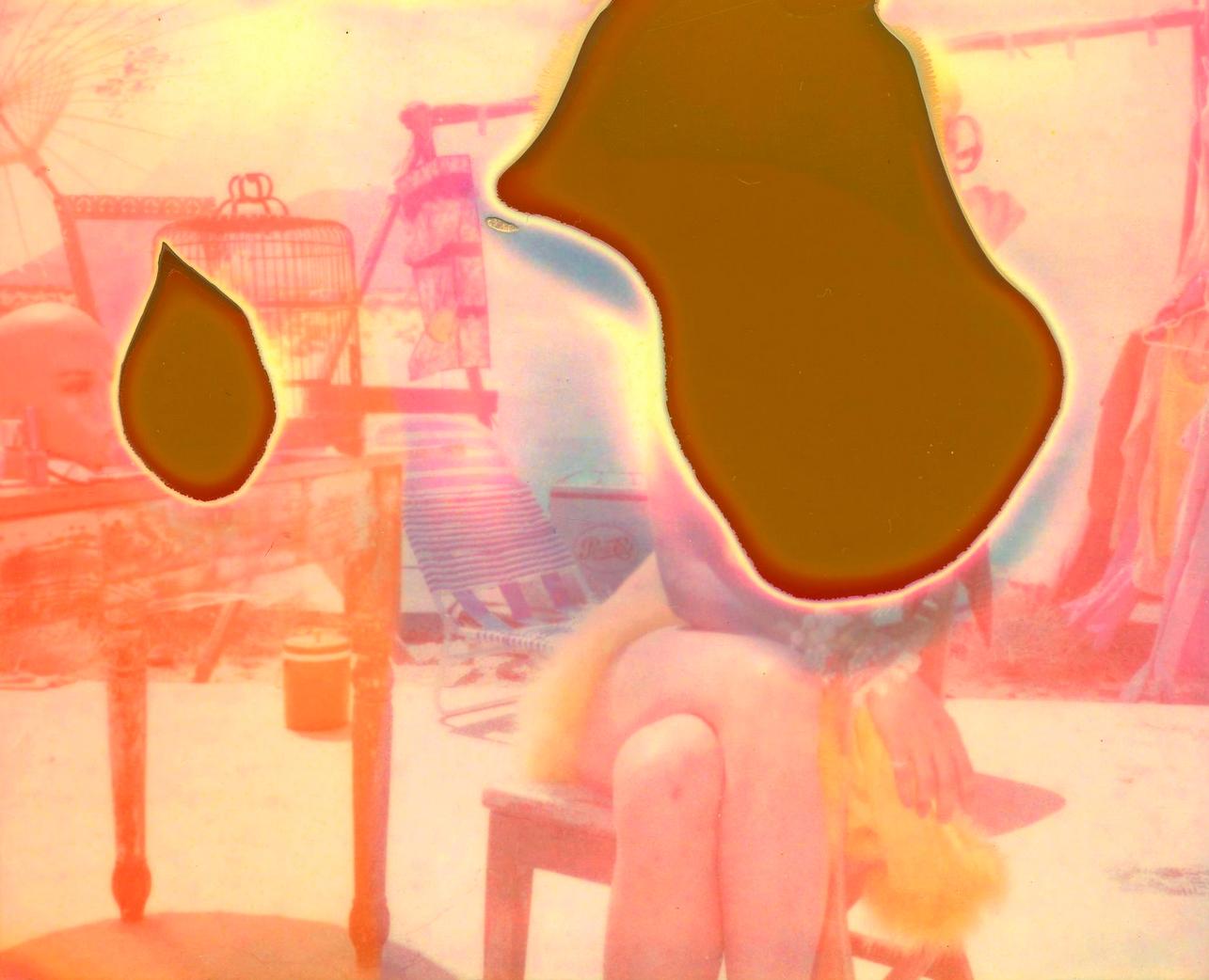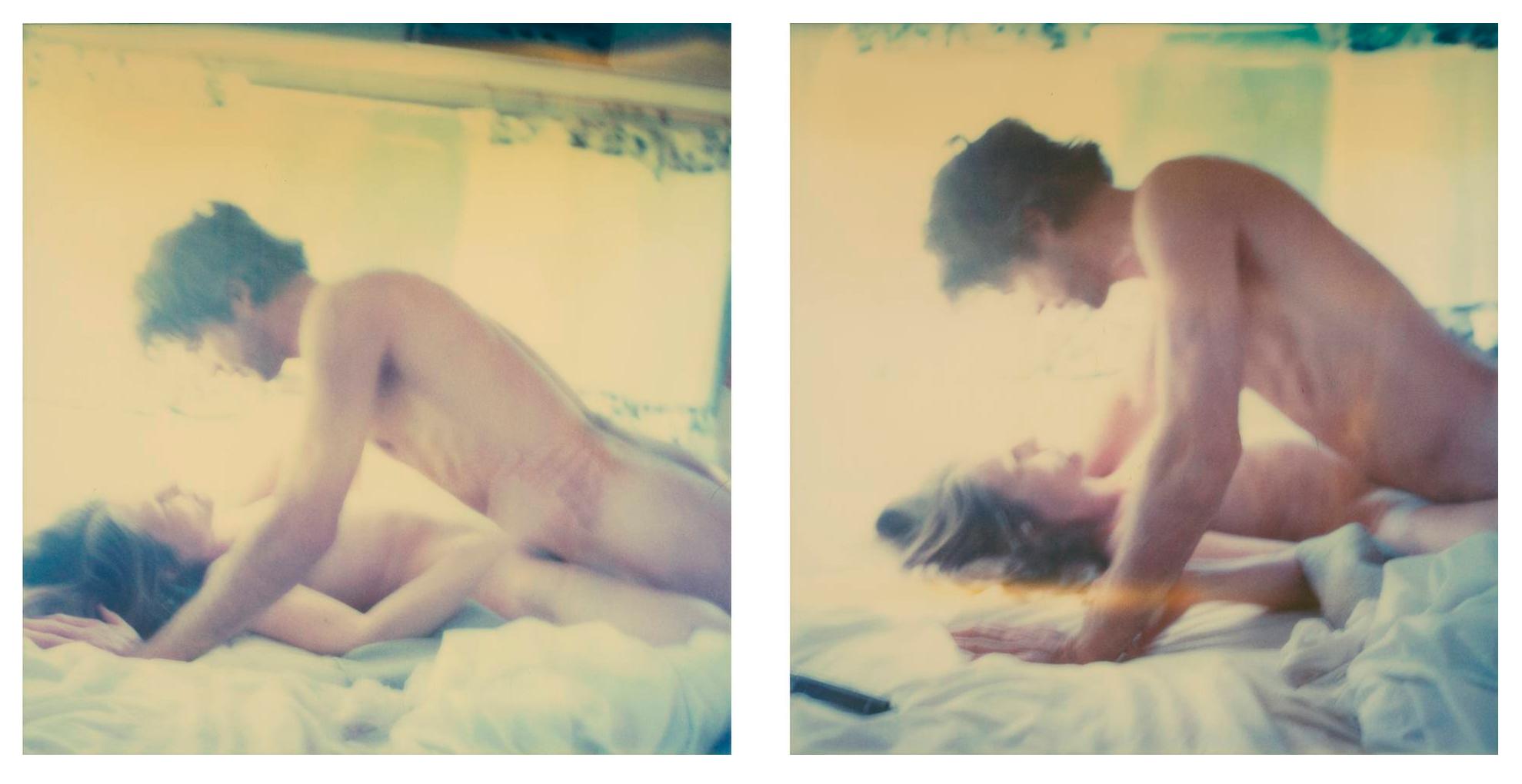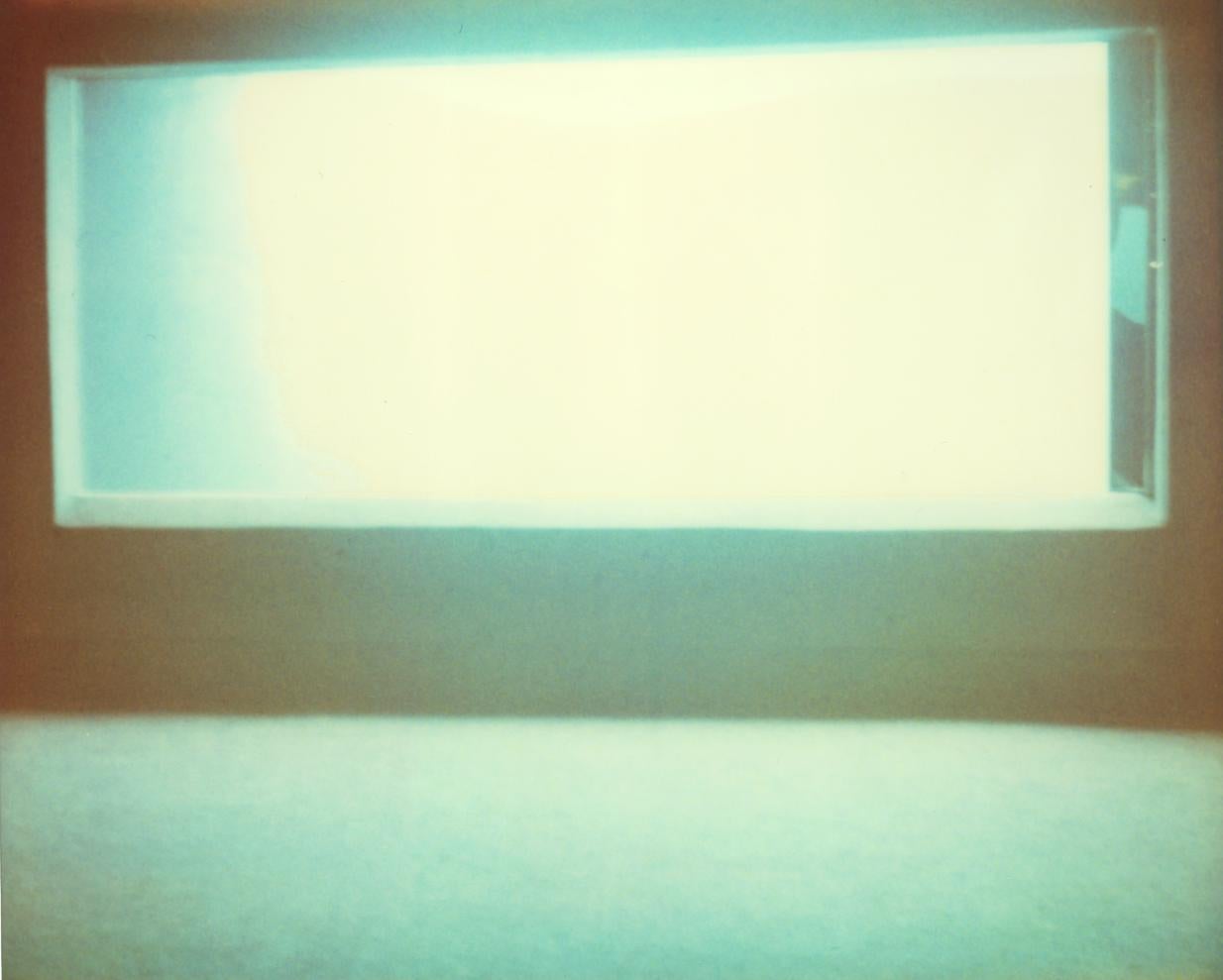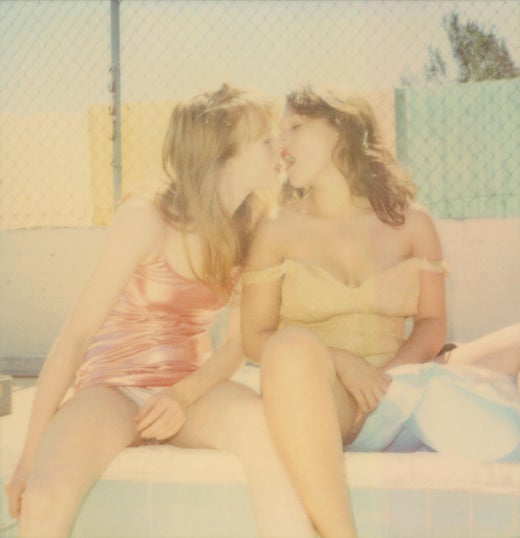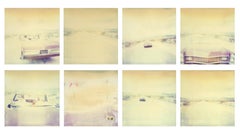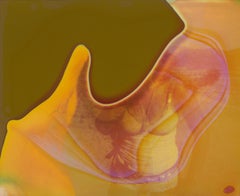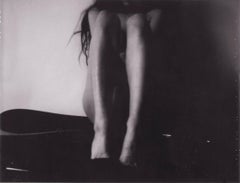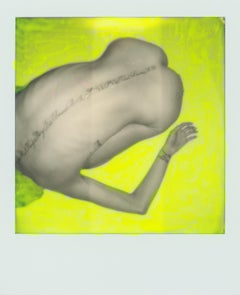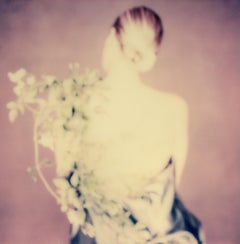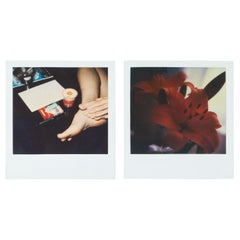Items Similar to Waiting III (Sidewinder) - Polaroid, Contemporary, 21st Century, Color
Want more images or videos?
Request additional images or videos from the seller
1 of 14
Stefanie SchneiderWaiting III (Sidewinder) - Polaroid, Contemporary, 21st Century, Color2005
2005
$3,000
£2,290.49
€2,646.64
CA$4,211.43
A$4,694.08
CHF 2,462.82
MX$57,322.37
NOK 31,184.69
SEK 29,474.27
DKK 19,753
About the Item
Waiting III (Sidewinder) 2005
60x140cm, including white frame,
Edition of 10,
Archival C-Print, based on the 10 Polaroids.
Signature label and Certificate.
Not mounted.
"Waiting III (Sidewinder)" unfolds like a whispered story—ten Polaroids suspended in time, each one a fragment of tension and tenderness. The series captures the interior of an Airstream trailer, its gauzy curtain diffusing the desert light into a ghostly hush. Beneath it, a naked woman lies alone on the bed, her body a quiet study in vulnerability. A pistol rests within reach—a stark, deliberate presence, neither fully threatening nor fully protective, but charged with possibility.
Schneider’s use of expired Polaroid film deepens the sense of impermanence. The chemical burns and fading edges echo the erosion of time and memory. We are not merely observing a moment—we are made to feel its weight, its loneliness, its unspoken threat. The woman’s stillness is not peace; it’s anticipation. Something has happened, or is about to.
The curtain acts as both veil and stage, suggesting a barrier between inner life and the outside world. This piece evokes the myth of the American West filtered through a woman’s solitude—fragile, defiant, unknowable. In Schneider’s world, waiting is never passive. It’s a state of heightened existence, where time stretches and intimacy clings to the air like dust.
"I am more than delighted to attest to Stefanie Schneider's trailblazing work that has changed the face of photography forever.
Do you believe in love at first sight? I do - ever since I saw Stefanie Schneider's artwork in a gallery in Hamburg, Germany. Never before have images drawn me in so immediately, affected me so profoundly, nor kept me so relentlessly under their spell. Never before have I sensed such a harmonious, quiet and yet mutually nourishing relationship between an artist and the medium that is an American icon: Polaroid film.
Stefanie has taken Polaroid photography to the highest level of attention and acclaim of any photographer in history, breaking new ground we never thought imaginable. No one before has utilized Polaroid film to such a degree, elevating it into the realm of pure fine art. It’s not an exaggeration to state that meeting Stefanie and seeing her exceptional work has changed my life forever, and was the catalyst that moved me to save Polaroid film when I had thoughts of shutting down production a few years ago. Indeed, she nearly single-handedly saved an industry and a filmic medium. That’s the sort of influence she has in her field.
In the years that followed my fateful decision inspired by the work of Ms. Schneider, Stefanie's stunning works have not only touched our own analog souls; her incredible ongoing worldwide success and growing exposure has also given a very clear signal that the time is now to collect, treasure and inhale the mysterious magic of Polaroid art.
Several weeks after first meeting her work, I had a chance to meet Stefanie in person and discovered that each of her intensive Polaroid images form part of an ambitious and extraordinary master plan - the largest Polaroid art project of all time: a full-length film almost completely made out of Polaroid materials and images called "29 Palms, CA." Immediately upon learning this, we started collecting expired film from all over the planet to support her vision. In return, Stefanie Schneider has allowed us to showcase a very special and lovingly composed collection of limited edition prints of her latest Polaroid shots and personal favorites at Polanoir, our Polaroid Gallery known throughout the world.
Today at Polanoid, now better known as THE IMPOSSIBLE PROJECT, we continue our fight against the downfall of Polaroid film and the closing of their facilities, hopes of keeping American jobs in addition to keeping viable a truly American-invented film stock like Polaroid, which has touched so many millions of lives throughout the years. We now call Polanoid ‘The Impossible Project' because many said it would be impossible to save Polaroid film. Hearing this, I recalled the words of Edward Land, the inventor of Polaroid film, who said the only projects worth attempting are something that is said to be “impossible.”
Which again brings us back to Ms. Schneider, who inspired me to start this company THE IMPOSSIBLE PROJECT after seeing her work, which seems to achieve the possible from the impossible, creating the finest of art out of the most basic of mediums and materials. Indeed, after that one day, I was so impressed with her photography that I realized Polaroid film could not be allowed to disappear. Being at the precise moment in time where the world was about to lose Polaroid, I seized the moment and have put all my efforts and passion into saving Polaroid film. For that, I thank Stefanie Schneider almost exclusively, who played a bigger role than anyone in saving this American symbol of photography.
Florian Kapps / founding President of Impossible Inc.
March 8th 2010
Stefanie Schneider received her MFA in Communication Design at the Folkwang Schule Essen, Germany. Her work has been shown at the Museum for Photography, Braunschweig, Museum für Kommunikation, Berlin, the Institut für Neue Medien, Frankfurt, the Nassauischer Kunstverein, Wiesbaden, Kunstverein Bielefeld, Museum für Moderne Kunst Passau, Les Rencontres d'Arles, Foto -Triennale Esslingen.
- Creator:Stefanie Schneider (1968, German)
- Creation Year:2005
- Dimensions:Height: 23.63 in (60 cm)Width: 55.12 in (140 cm)Depth: 0.04 in (1 mm)
- Medium:
- Movement & Style:
- Period:
- Condition:
- Gallery Location:Morongo Valley, CA
- Reference Number:1stDibs: LU652316369972
Stefanie Schneider
Stefanie Schneider received her MFA in Communication Design at the Folkwang Schule Essen, Germany. Her work has been shown at the Museum for Photography, Braunschweig, Museum für Kommunikation, Berlin, the Institut für Neue Medien, Frankfurt, the Nassauischer Kunstverein, Wiesbaden, Kunstverein Bielefeld, Museum für Moderne Kunst Passau, Les Rencontres d'Arles, Foto -Triennale Esslingen., Bombay Beach Biennale 2018, 2019.
About the Seller
4.9
Platinum Seller
Premium sellers with a 4.7+ rating and 24-hour response times
Established in 1996
1stDibs seller since 2017
1,034 sales on 1stDibs
Typical response time: 3 hours
- ShippingRetrieving quote...Shipping from: Morongo Valley, CA
- Return Policy
Authenticity Guarantee
In the unlikely event there’s an issue with an item’s authenticity, contact us within 1 year for a full refund. DetailsMoney-Back Guarantee
If your item is not as described, is damaged in transit, or does not arrive, contact us within 7 days for a full refund. Details24-Hour Cancellation
You have a 24-hour grace period in which to reconsider your purchase, with no questions asked.Vetted Professional Sellers
Our world-class sellers must adhere to strict standards for service and quality, maintaining the integrity of our listings.Price-Match Guarantee
If you find that a seller listed the same item for a lower price elsewhere, we’ll match it.Trusted Global Delivery
Our best-in-class carrier network provides specialized shipping options worldwide, including custom delivery.More From This Seller
View AllWaiting II (Sidewinder) - Polaroid, Contemporary, Nude, 21st Century
By Stefanie Schneider
Located in Morongo Valley, CA
'Waiting II' (Sidewinder) - 2004
80x80cm,
Edition of 5,
analog C-Print, hand-printed by the artist, based on the Polaroid,
Certificate and Signature label.
artist Inventory # 303...
Category
Early 2000s Contemporary Color Photography
Materials
Archival Paper, Photographic Paper, C Print, Color, Polaroid
Leaving III (Sidewinder) - Polaroid, 21st Century, Contemporary
By Stefanie Schneider
Located in Morongo Valley, CA
Leaving III (Sidewinder) - 2005
60x110cm,
Edition of 10.
Archival C-Print based on a Polaroid.
Signature label and Certificate.
Artist Inventory No. 3463.
Not mounted.
Stefanie ...
Category
Early 2000s Contemporary Portrait Photography
Materials
Archival Paper, Photographic Paper, C Print, Color, Polaroid
Living in a Dream (Till Death do us Part) - Contemporary, Polaroid, Women
By Stefanie Schneider
Located in Morongo Valley, CA
Living in a Dream (Till Death do us Part) - 2005
20x20cm,
Edition of 10,
Archival C-Print print, based on the Polaroid.
Certificate and Signature label, artist Inventory No. 9781.
Not mounted.
on offer is a piece from the movie "Till Death do us Part"
Stefanie Schneider’s Till Death Do Us Part
or “There is Only the Desert for You.”
BY DREW HAMMOND
Stefanie Schneider’s Til Death to Us Part is a love narrative that comprises three elements:
1.
A montage of still images shot and elaborated by means of her signature technique of using Polaroid formats with outdated and degraded film stock in natural light, with the resulting im ages rephotographed (by other means) enlarged and printed in such a way as to generate further distortions of the image.
2.
Dated Super 8 film footage without a sound track and developed by the artist.
3.
Recorded off-screen narration of texts written by the actors or photographic subjects, and selected by the artist.
At the outset, this method presupposes a tension between still and moving image; between the conventions about the juxtaposition of such images in a moving image presentation; and, and a further tension between the work’s juxtaposition of sound and image, and the conventional relationship between sound and image that occurs in the majority of films. But Till Death Do Us Part also conduces to an implied synthesis of still and moving image by the manner in which the artist edits or cuts the work.
First, she imposes a rigorous criterion of selection, whether to render a section as a still or moving image. The predominance of still images is neither an arbitrary residue of her background as a still photographer—in fact she has years of background in film projects; nor is it a capricious reaction against moving picture convention that demands more moving images than stills. Instead, the number of still images has a direct thematic relation to the fabric of the love story in the following sense. Stills, by definition, have a very different relationship to time than do moving images. The unedited moving shot occurs in real time, and the edited moving shot, despite its artificial rendering of time, all too 2009often affords the viewer an even greater illusion of experiencing reality as it unfolds. It is self-evident that moving images overtly mimic the temporal dynamic of reality.
Frozen in time—at least overtly—still photographic images pose a radical tension with real time. This tension is all the more heightened by their “real” content, by the recording aspect of their constitution. But precisely because they seem to suspend time, they more naturally evoke a sense of the past and of its inherent nostalgia. In this way, they are often more readily evocative of other states of experience of the real, if we properly include in the real our own experience of the past through memory, and its inherent emotions.
This attribute of stills is the real criterion of their selection in Til Death Do Us Part where consistently, the artist associates them with desire, dream, memory, passion, and the ensemble of mental states that accompany a love relationship in its nascent, mature, and declining aspects.
A SYNTHESIS OF MOVING AND STILL IMAGES BOTH FORMAL AND CONCEPTUAL
It is noteworthy that, after a transition from a still image to a moving image, as soon as the viewer expects the movement to continue, there is a “logical” cut that we expect to result in another moving image, not only because of its mise en scène, but also because of its implicit respect of traditional rules of film editing, its planarity, its sight line, its treatment of 3D space—all these lead us to expect that the successive shot, as it is revealed, is bound to be another moving image. But contrary to our expectation, and in delayed reaction, we are startled to find that it is another still image.
One effect of this technique is to reinforce the tension between still and moving image by means of surprise. But in another sense, the technique reminds us that, in film, the moving image is also a succession of stills that only generate an illusion of movement. Although it is a fact that here the artist employs Super 8 footage, in principle, even were the moving images shot with video, the fact would remain since video images are all reducible to a series of discrete still images no matter how “seamless” the transitions between them.
Yet a third effect of the technique has to do with its temporal implication. Often art aspires to conflate or otherwise distort time. Here, instead, the juxtaposition poses a tension between two times: the “real time” of the moving image that is by definition associated with reality in its temporal aspect; and the “frozen time” of the still image associated with an altered sense of time in memory and fantasy of the object of desire—not to mention the unreal time of the sense of the monopolization of the gaze conventionally attributed to the photographic medium, but which here is associated as much with the yearning narrator as it is with the viewer.
In this way, the work establishes and juxtaposes two times for two levels of consciousness, both for the narrator of the story and, implicitly, for the viewer:
A) the immediate experience of reality, and
B) the background of reflective effects of reality, such as dream, memory, fantasy, and their inherent compounding of past and present emotions.
In addition, the piece advances in the direction of a Gesammtkunstwerk, but in a way that reconsiders this synaesthesia as a unified complex of genres—not only because it uses new media that did not exist when the idea was first enunciated in Wagner’s time, but also because it comprises elements that are not entirely of one artist’s making, but which are subsumed by the work overall. The totality remains the vision of one artist.
In this sense, Till Death Do Us Part reveals a further tension between the central intelligence of the artist and the products of other individual participants. This tension is compounded to the degree that the characters’ attributes and narrated statements are part fiction and part reality, part themselves, and part their characters. But Stefanie Schneider is the one who assembles, organizes, and selects them all.
THE RELATIONSHIP BETWEEN THIS IDEA (above) AND PHOTOGRAPHY
This selective aspect of the work is an expansion of idea of the act of photography in which the artistic photographer selects that which is already there, and then, by distortion, definition or delimitation, compositional and lighting emphasis, and by a host of other techniques, subsumes that which is already there to transform it into an image of the artist’s contrivance, one that is no less of the artist’s making than a work in any other medium, but which is distinct from many traditional media (such as painting) in that it retains an evocation of the tension between what is already there and what is of the artist’s making. Should it fail to achieve this, it remains, to that degree, mere illustration to which aesthetic technique has been applied with greater or lesser skill.
The way Til Death Do Us Part expands this basic principle of the photographic act, is to apply it to further existing elements, and, similarly, to transform them. These additional existing elements include written or improvised pieces narrated by their authors in a way that shifts between their own identities and the identities of fictional characters. Such characters derive partially from their own identities by making use of real or imagined memories, dreams, fears of the future, genuine impressions, and emotional responses to unexpected or even banal events. There is also music, with voice and instrumental accompaniment. The music slips between integration with the narrative voices and disjunction, between consistency and tension. At times it would direct the mood, and at other times it would disrupt.
Despite that much of this material is made by others, it becomes, like the reality that is the raw material of an art photo, subsumed and transformed by the overall aesthetic act of the manner of its selection, distortion, organization, duration, and emotional effect.
* * *
David Lean was fond of saying that a love story is most effective in a squalid visual environment. In Til Death Do Us Part, the squalor of the American desert...
Category
Early 2000s Contemporary Color Photography
Materials
Archival Paper, Photographic Paper, C Print, Color, Polaroid
Chronometry (Stage of Consciousness) - Polaroid
By Stefanie Schneider
Located in Morongo Valley, CA
Chronometry (Stage of Consciousness) - 2008
20x20cm,
Edition of 10,
Archival C-Print, based on the Polaroid.
Certificate and Signature label.
Artist Inventory #6426
Not mounte...
Category
Early 2000s Contemporary Color Photography
Materials
Photographic Film, Archival Paper, C Print, Color, Polaroid
Moments in Time (Sidewinder) - Polaroid
By Stefanie Schneider
Located in Morongo Valley, CA
Moments in Time (Sidewinder) - 2008
20x20cm,
Edition of 10,
Archival C-Print, based on the Polaroid.
Certificate and Signature label.
Artist Inventory #3331
Not mounted.
Stef...
Category
Early 2000s Contemporary Color Photography
Materials
Photographic Film, Archival Paper, C Print, Color, Polaroid
Silence Void (Stay) - Polaroid
By Stefanie Schneider
Located in Morongo Valley, CA
Silence Void (Stay) - 2006
20x20cm,
Edition of 10,
Archival C-Print, based on the Polaroid.
Certificate and Signature label.
Artist Inventory No. 2116.
Not mounted.
Stefanie...
Category
Early 2000s Contemporary Color Photography
Materials
Photographic Film, Archival Paper, C Print, Color, Polaroid
You May Also Like
Chelsea Hotel #3 – Emma Summerton, Polaroid, Interior, Woman, Nude, Polaroid
By Emma Summerton
Located in Zurich, CH
Emma SUMMERTON (*1970, Australia)
Chelsea Hotel #3, 2003
Archival pigment print on Hahnemühle Paper
100 x 120 cm (39 3/8 x 47 1/4 in.)
Edition of 5, plus 2 AP; Ed. no. 1/5
Print only...
Category
Early 2000s Contemporary Color Photography
Materials
Archival Pigment
Price Upon Request
Free Shipping
"Pola Girls 7" Nude Polaroid Photography - Unique piece by Larsen Sotelo
By Larsen Sotelo
Located in Culver City, CA
"Pola Girls 7" Nude Polaroid Photography - Unique piece by Larsen Sotelo
4.2" x 3.5" inch - including white Polaroid frame
3.1" x 3,1" inch - image area
C...
Category
21st Century and Contemporary Contemporary Nude Photography
Materials
Polaroid
Jasmine - 21st Century Contemporary Photographic Print Color Polaroid
By Pia Clodi
Located in Zürich, CH
Part of the BLOOMY VIEW series taken in Bern 2020 in collaboration with Heym Collections, the images gained new life in their ambiguity, which often stimulates the viewer to project ...
Category
2010s Contemporary Abstract Prints
Materials
Carbon Pigment, Polaroid
$1,792 Sale Price
20% Off
Miquel Arnal Set of Polaroid Photographs
By Miquel Arnal
Located in Barcelona, Barcelona
Set of Polaroid photographs by Miquel Arnal.
In original condition, with minor wear consistent with age and use, preserving a beautiful patina.
Material:
Photographic paper
...
Category
1990s Spanish Post-Modern Photography
Materials
Paper
$631 Sale Price / set
30% Off
Lying in the Past
By Sarah Hadley
Located in Los Angeles, CA
Archival pigment print
Hand printed by Sarah Hadley on Canson Baryta Photo paper
From the series In Between Days
Sarah Hadley is a Los Angeles based artist whose narrative work focuses on issues of female identity and memory.
Hadley's photographs have been exhibited at the Milan Photo...
Category
2010s Romantic Color Photography
Materials
Archival Ink, Archival Paper, Photographic Paper
Awake Asleep AC – Emma Summerton, Polaroid, Colour, Light, Sunbeam, Hotel room
By Emma Summerton
Located in Zurich, CH
Emma SUMMERTON (*1970, Australia)
Awake Asleep AC, 2008
Archival pigment print on Hahnemühle Paper
100 x 120 cm (39 3/8 x 47 1/4 in.)
Edition of 5, plus 2 AP; Ed. no. 2/5
Print only
Australian born Emma Summerton (*1970) graduated from the National Art School in Sydney, where she studied fine arts majoring in Photography. Summerton moved to London in 1998, where she worked as an assistant to artist Fiona Banner...
Category
Early 2000s Contemporary Color Photography
Materials
Archival Pigment
Price Upon Request
Free Shipping
More Ways To Browse
Day Bed Used
Woman With A Veil
Green Bed Frame
Palm Bed
Curtain Weights
Magic Spells
Design Within Reach Bed
Roy Lichtenstein Signed
Antique Portrait Miniature
David Winter
Life Size Dog
Painted Stained Glass Window
Used Couches Chicago
Airline Poster
Car Wall Art
Henry Moore Signed
Pub Art
California Woman Artists Landscape
